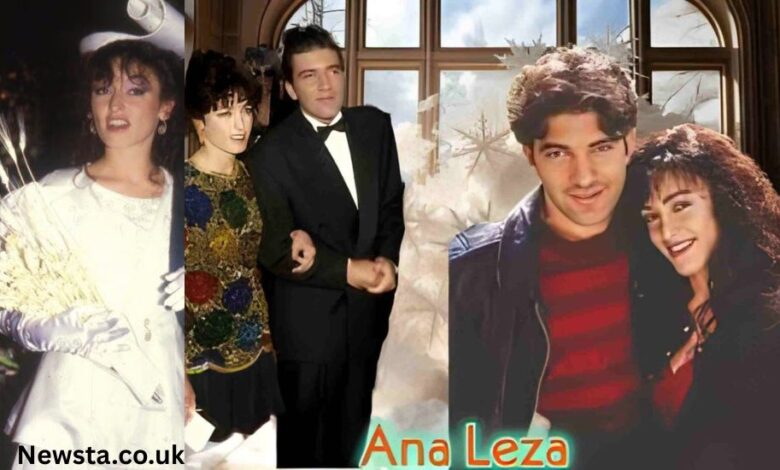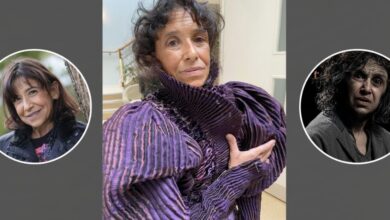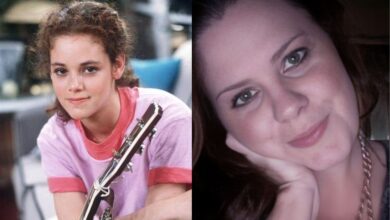Ana Leza: The Woman Behind the Fame and Her Journey to Inner Peace

In the glittering world of cinema, where fame often shines on only a few, there are those whose lives unfold quietly, beautifully, and meaningfully beyond the bright lights. One such figure is Ana Leza, the Spanish actress best known not only for her early work in film but also for her pivotal role in shaping the career of her former husband, international star Antonio Banderas. Her journey—from Madrid’s vibrant artistic scene to a peaceful, spiritual life in California—is a remarkable tale of transformation, resilience, and rediscovery.
Early Life and Family Background
Born in Madrid in 1962, Ana Leza grew up surrounded by art and creativity. Her mother, Concha Leza, was a respected Spanish stage actress who instilled in her daughter a love for performance and language from an early age. The household was deeply connected to the theater world, nurturing Ana’s exposure to acting, storytelling, and the expressive traditions of Spanish cinema.
Spain in the 1970s and 1980s was a country undergoing cultural revival. As democracy returned after years of dictatorship, Madrid became a hub for new art, film, and social freedom. Young artists like Ana Leza thrived in this atmosphere. It was during this period that she began to pursue acting seriously, studying theater and gaining experience on stage before moving into film and television.
The Start of Her Acting Career
Ana Leza’s acting career blossomed in the late 1980s, a period that saw a wave of innovation in Spanish cinema led by directors such as Pedro Almodóvar. Her work reflected the vitality of this era—bold, emotional, and modern.
Her most recognized role came in “Mujeres al borde de un ataque de nervios” (Women on the Verge of a Nervous Breakdown), released in 1988, one of Almodóvar’s most iconic films. The movie became an international success, earning global acclaim and helping launch Spanish cinema into worldwide recognition. Though Ana’s role was supporting, it placed her alongside a talented cast and introduced her to the growing network of Spain’s modern film elite.
She also appeared in “Of Love and Shadows” (1994), an adaptation of Isabel Allende’s novel, where she showed her depth and versatility as an actress. Her performances were natural, expressive, and carried a quiet intensity that critics praised for its authenticity. Yet, unlike many of her contemporaries, Ana Leza did not pursue fame aggressively. She valued the art more than the spotlight.
Love and Marriage with Antonio Banderas
Ana Leza’s life took a fateful turn when she met a young, ambitious actor named Antonio Banderas. The two crossed paths in Madrid’s artistic circles in the mid-1980s, sharing the same passion for film and culture. Their chemistry was instant. On 27 July 1987, the couple married in Madrid in a beautiful and intimate ceremony.
At the time, Banderas was still an emerging actor, known mainly in Spain for his collaborations with Almodóvar. Ana became not only his wife but also his most trusted partner and guide. She spoke fluent English, while Banderas did not—a skill that would later prove critical when his career expanded internationally.
In 1991, when Banderas was invited to audition in Hollywood for “The Mambo Kings,” Ana Leza’s linguistic and cultural fluency helped him navigate the challenges of the English-speaking world. She translated scripts, coached him in English pronunciation, and served as a bridge between him and American directors. It is widely acknowledged in Spanish media and interviews that Ana played a key role in helping Antonio Banderas transition into the global film industry.
Life in Hollywood and Cultural Challenges
The couple relocated to the United States as Banderas’s Hollywood career began to soar. They attended red-carpet events together, appearing as one of Spain’s most glamorous duos. Yet behind the smiles, Ana Leza found the shift to Hollywood life disorienting. The cultural differences, the constant attention, and the media scrutiny created tension in their marriage.
Ana preferred quiet reflection, meaningful work, and family closeness—values often at odds with the fast-paced, competitive world of Los Angeles. While Banderas’s fame continued to rise with films such as Philadelphia (1993) and Desperado (1995), Ana’s presence gradually faded from the public eye.
Divorce and Reinvention
In 1996, after nearly a decade of marriage, Ana Leza and Antonio Banderas divorced. The separation made headlines across Spain, and her private life was suddenly exposed to a media storm. While Banderas would soon remarry actress Melanie Griffith, Ana withdrew from the spotlight almost entirely.
Unlike many who might chase relevance after such a public breakup, Ana Leza chose another path—reinvention. She turned inward, embracing spirituality and self-discovery. Her decision reflected a deep resilience and independence, showing that identity need not depend on fame or association with another’s success.
A New Life and Spiritual Journey
After her divorce, Ana relocated to the United States, where she began to study and practice Siddha Yoga and meditation through the SYDA Foundation. This period marked a profound transformation in her life. Reports from Spanish and English blog sources describe her as deeply devoted to spiritual growth and living a peaceful, mindful existence away from the chaos of celebrity culture.
In 2000, Ana married Dharma Villareal (born Christopher Lee Villareal), a film editor and yoga practitioner based in Los Angeles. Together, they built a life rooted in spirituality and family. The couple has two daughters and resides in California, where Ana continues to teach, translate, and remain involved in yoga and meditation practices.
Her new life reflects a woman who has found inner stability after years of turbulence. She exchanged the glitz of Madrid and Hollywood for simplicity, devotion, and peace. Friends and family describe her as warm, introspective, and deeply committed to personal growth.
Entrepreneurial Ventures and Creative Work
Beyond her spiritual pursuits, Ana also explored creative and entrepreneurial interests. For a time, she ran Vinaya Dosa SL, a small design and architecture-related business in Spain. Although short-lived, this project reflected her passion for aesthetics and structure—echoing her early love for theater and storytelling.
Ana Leza has also done translation and voice work, utilizing her bilingual skills in Spanish and English. Some reports note that she occasionally collaborates with spiritual and artistic organizations to promote mindfulness and creative expression.
The Quiet Legacy of Ana Leza
While Ana Leza’s name is often remembered in connection to Antonio Banderas, her personal legacy goes far beyond being a “former spouse.” She represents the archetype of a woman who finds strength in stillness. Her influence may not be loud, but it is enduring—especially in how she helped shape one of Spain’s greatest international stars while also defining her own spiritual and personal identity.
Her life story challenges modern ideas about success. Fame fades; peace endures. In an era when celebrity often overshadows humanity, Ana Leza stands as a reminder that fulfillment can come from self-knowledge and authenticity rather than public applause.
Ana Leza in Retrospect: Beyond Fame
If one were to trace her timeline, it would show a life lived in three distinct acts:
- The Artist – A talented actress in Madrid’s golden cinema era, contributing to films that helped define Spain’s cultural resurgence.
- The Partner – A supportive, multilingual figure who guided her husband’s career and opened doors for him on the global stage.
- The Seeker – A woman who stepped away from fame to find spiritual clarity and happiness, redefining her purpose in a more profound way.
Each stage reveals a layer of emotional intelligence, courage, and grace. Ana Leza may have left the stage, but her story continues to inspire those who value personal evolution over external recognition.
Why Ana Leza’s Story Still Matters
In today’s media landscape, where visibility is often mistaken for success, Ana Leza’s journey offers a rare alternative. It shows that a meaningful life can exist beyond fame—that success can be measured by inner peace, self-understanding, and the ability to reinvent oneself.
Her influence on Spanish cinema, her quiet support of Antonio Banderas during his formative years, and her later dedication to spirituality make her a figure worthy of renewed appreciation.
Ana Leza’s story resonates with anyone who has ever chosen authenticity over image. She reminds us that life’s truest stage is the one within—where we learn, grow, and become who we are meant to be.
Conclusion
Ana Leza’s life is more than a footnote in someone else’s biography. It is the story of a woman who lived passionately, loved deeply, and ultimately found peace in simplicity. From her early acting days in Madrid to her spiritual life in California, her journey is a testament to transformation, resilience, and the quiet power of self-reinvention.
In the end, Ana Leza embodies the idea that fame is fleeting, but grace is timeless.
Thanks for read our article if you want more like this kind of article visit our site Newsta, and comment us. We provide authentic & comprehensive information to our readers.
1. Who is Ana Leza?
Ana Leza is a Spanish actress best known for her roles in late-1980s Spanish cinema, particularly Women on the Verge of a Nervous Breakdown. She was also the first wife of actor Antonio Banderas and later became known for her spiritual and private lifestyle.
2. When and where was Ana Leza born?
She was born in 1962 in Madrid, Spain, into an artistic family. Her mother, Concha Leza, was a well-known stage actress.
3. What are Ana Leza’s most famous movies?
Her notable films include “Mujeres al borde de un ataque de nervios” (Women on the Verge of a Nervous Breakdown, 1988) and “Of Love and Shadows” (1994).
4. When did Ana Leza and Antonio Banderas get married and divorced?
Ana Leza and Antonio Banderas married on July 27, 1987, in Madrid and divorced in 1996, after almost nine years of marriage.
5. What was Ana Leza’s role in Antonio Banderas’s Hollywood career?
Ana played a crucial part in helping Banderas transition to Hollywood by translating scripts, teaching him English, and guiding him through cultural adjustments in the United States.
6. What does Ana Leza do now?
Ana Leza now lives a private life in the United States, where she practices Siddha Yoga, teaches meditation, and focuses on spirituality and family life.
7. Who is Ana Leza married to now?
Since 2000, Ana Leza has been married to Dharma Villareal (Christopher Lee Villareal), a film editor and yoga practitioner. They have two daughters together.
8. Why did Ana Leza leave acting?
After her divorce and move to the U.S., Ana shifted her focus from acting to spiritual growth and family, preferring a peaceful, private lifestyle over public fame.
9. Is Ana Leza active on social media?
No. Ana Leza maintains a private life and does not appear to have any official social-media accounts.
10. What makes Ana Leza’s story inspiring?
Her journey—from celebrated actress to spiritual devotee—shows the power of reinvention, self-discovery, and inner peace, inspiring many to value authenticity over fame.



